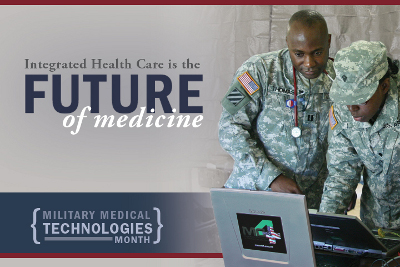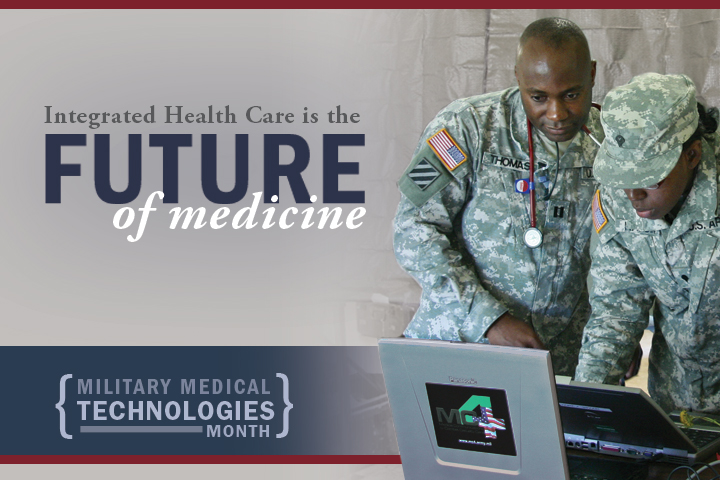Military Medical Technologies
MHS on the Cutting Edge
 Every day all over the world, technology improves the way we live. The Internet, solar power, advanced robotics and lasers are just a few advances of the modern era. Medical innovations have included the development of myoelectric prosthetics, screen readers to help the visually impaired, and mobile electronic health records.
Every day all over the world, technology improves the way we live. The Internet, solar power, advanced robotics and lasers are just a few advances of the modern era. Medical innovations have included the development of myoelectric prosthetics, screen readers to help the visually impaired, and mobile electronic health records.
The Department of Defense’s Military Health System remains at the forefront of developing and adapting medical devices and technologies to support our service members and their families, ensuring the highest quality care at all times.
This November, we celebrate these advancements during Military Medical Technologies month. As the number of beneficiaries and wounded warriors continues to grow, the MHS is continually developing innovative, interoperable and integrated solutions. In addition to our 9.6 million beneficiaries, we support more than 140,000 care providers, educators, trainers and medical researchers with world-class health information technology solutions and products.
Click on the links below to learn about the programs and capabilities that keep the MHS at the forefront of health care delivery.
MC4 Battlefield EMR Video
When a solider is critically wounded, there’s the platinum 10-minutes front-line medics have to stabilize him. Every minute counts, so they must react immediately. This video provides an overview of how medical information is documented electronically from point-of-injury through the level of care that follow, giving care providers situational awareness and allowing them to provide the best care possible.
This is OCIO Video
The MHS Office of the Chief Information Officer is breaking new ground in healthcare IM/IT in a way that supports all of MHS benefiticiars, past, present, and future. This video provides an overview of the OCIO with a message from former CIO, Chuck Campbell.
Theme Graphics for You to Use
Right-click and save the images, and spread the word about military medical technology!


MHS Organizations and Partners
 | AHLTA Electronic Health Records - AHLTA, the military's electronic health record (EHR), marks a significant new era in healthcare for the Military Health System and the nation. In his January 2004 State of the Union address, President George W. Bush set the goal of ensuring most Americans had an EHR by 2014. The Department of Defense is leading this effort by completing the implementation of AHLTA, the interoperable, globally accessible, protected and always available EHR for uniformed services members, retirees and their families by 2011. |
 | U.S. Army Medical Information Technology Center - The U.S. Army Medical Information Technology Center provides information management/information technology products and services to support the Army Medical Department, the Military Health System, Department of Defense and other government clients. |
 | Computer/Electronic Accommodations Program - The Computer/Electronic Accommodations Program (CAP) provides assistive technology and services to people with disabilities, federal managers, supervisors and IT professionals. CAP increases access to information and works to remove barriers to employment opportunities by eliminating the costs of assistive technology and accommodation solutions. |
 | Defense Centers of Excellence - National Center for Telehealth and Technology - The National Center for Telehealth and Technology (T2) researches, develops, evaluates and deploys new and existing technologies for psychological health and traumatic brain injury (TBI) across the Department of Defense. The T2 center meets this mission by serving as the principal DoD coordinator in such areas as innovative technology applications, suicide surveillance and prevention, online behavioral health tools and telepsychological health. |
 | Defense Health Information Management System - The Defense Health Information Management System (DHIMS) provides information management and IT solutions that capture, manage and share health care data for the military's electronic health record (EHR). The EHR is used by the military's medical community and supports the management of more than 9.5 million Military Health System beneficiary records. DHIMS provides one of the largest -- and most comprehensive -- EHRs in the world and is committed to delivering clinical IT solutions that enable continuity of care and timely administration of benefits to service members and their families. |
 | Defense Health Services Systems - The DHSS is a new program office in the MHS that incorporates products and functionality from the former DMLSS, EIDS and the RITPO. This merger will capitalize on best practices resulting in reduced time to market, economies of scale, and improved product quality. DHSS is building or maintaining more than 30 products used throughout the MHS in three major areas: clinical support, medical logistics and resources. |
 | Defense Medical Logistics Standard Support - The DMLSS program is a partnership involving the wholesale medical logistics, medical information management, medical information technology and user communities. DMLSS's mission is to improve responsiveness of medical logistics support. The DMLSS program accomplishes this by implementing business process innovations that increase the effectiveness of medical logistics support and reduce cost. |
 | Force Health Protection and Readiness Deployment Technologies and Support Programs - Deployment Technologies and Support Programs (DT&SP) supports the Director, Force Health Protection and Readiness Programs by acting as DoD's functional representative for theater information management and information technology initiatives. DT&SP provides oversight for theater health-related technology programs to ensure that DoD maximizes the use of technology and information systems to improve mission delivery and performance. |
 | Medical Communication for Combat Casualty Care (MC4) - Medical Communications for Combat Casualty Care integrates, fields and supports a comprehensive medical information system, enabling lifelong electronic medical records, streamlined medical logistics and enhanced situational awareness for Army tactical forces. |
 | Military Health System Office of the Chief Information Officer - The Military Health System Chief Information Officer (MHS CIO) has embraced a business philosophy endeavor that capitalizes upon technology and commercial best business practices by creating an enterprise knowledge management environment. The MHS CIO's Single Source is that "one-stop shopping" portal for all enterprise guidance and general informational needs. |
 | Military Operational Medicine Research Program - The Military Operational Medicine Research Program provides biomedical solutions that protect soldiers and enhance their performance in operational and training environments that include multiple stressors. It is a unique biomedical research program with relevant program areas, a problem-solving orientation and a human physiology research focus. |
 | TRICARE: Information Technology - TRICARE is leading the nation in the adoption of health information technology systems not only to manage the program behind the scenes, but to make TRICARE more convenient for you! Here are some of the Military Health System’s cutting-edge IT programs. |
 | TRICARE Operations Center - This health care information Web portal provides decision makers at all levels of the organization with meaningful, easy-to-use, Web-based operational tools and reports. |
 | Uniformed Services University, National Capital Area Medical Simulation Center - The Medical Simulation Center is divided into four main functional areas. Clinical Skills Teaching and Assessment Laboratory, the VTC Room and Computer Laboratory and the Surgical Simulation Laboratory are each divided into distinct sections that sustain and, when necessary, integrate the operations of the entire center. The Clinical Skills Teaching and Assessment Laboratory is an ideal setting for simulated patent encounters. The VTC Room functions as both a tool for distance learning, and a conference room. The Computer Laboratory is designed for the development of medical education software and the administration of clinical examinations. The Surgical Simulation Laboratory uses a full-scale operating room mock-up and virtual reality to provide highly realistic scenarios for surgical training. |
Technology in Action: Support for Wounded Warriors
 | Air Force Wounded Warrior - The Air Force will take care of its wounded warriors. It will fully support the Office of the Secretary of Defense programs to keep highly skilled men and women on active duty. If this is not feasible, the Air Force will ensure airmen receive enhanced assistance through the AFW2 program. |
 | Army Wounded Warrior Program - The Army Wounded Warrior Program (AW2) is the official U.S. Army program that assists and advocates for severely wounded, injured, and ill soldiers, veterans, and their families, wherever they are located, for as long as it takes. AW2 provides individualized support to this unique population of soldiers, who were injured or became ill during their service in overseas contingency operations since 9/11. |
 | U.S. Army Warrior Transition Command - The Warrior Transition Command (WTC) is a new one-star command under U.S. Army Medical Command that serves as the organizational focal point for the Army's Warrior Care and Transition Program. |
 | Marine Corps - Wounded Warrior Regiment - The Wounded Warrior Regiment's mission is to provide and facilitate assistance to wounded/injured/ill Marines, sailors attached to or in support of Marine units and their family members throughout the phases of recovery. |
 | Navy Safe Harbor - Safe Harbor is the Navy's lead organization for coordinating the non-medical care of wounded, ill and injured sailors, Coast Guardsmen and their families. Through proactive leadership, it provides a lifetime of individually tailored assistance designed to optimize the success of our shipmates' recovery, rehabilitation and reintegration activities. |
 | TRICARE Wounded, Ill, Injured Toolkit - TRICARE's toolkit for wounded, ill and injured service members have provides a variety of communications vehicles for you to view and use whenever suitable in educating audiences regarding their TRICARE benefits. |
 | Veterans Administration - Returning Service Members (OIF/OEF) - VA is ready to provide health care and more to our newest veterans returning from the armed services. |
 | Wounded Warrior Resource Center - The Wounded Warrior Resource Center is a Department of Defense Web site that provides wounded service members, their families and caregivers with information they need on military facilities, health care services and benefits. |